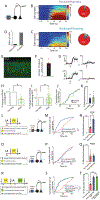Somatostatin-Expressing Interneurons Enable and Maintain Learning-Dependent Sequential Activation of Pyramidal Neurons
- PMID: 30792151
- PMCID: PMC6555419
- DOI: 10.1016/j.neuron.2019.01.036
Somatostatin-Expressing Interneurons Enable and Maintain Learning-Dependent Sequential Activation of Pyramidal Neurons
Abstract
The activities of neuronal populations exhibit temporal sequences that are thought to mediate spatial navigation, cognitive processing, and motor actions. The mechanisms underlying the generation and maintenance of sequential neuronal activity remain unclear. We found that layer 2 and/or 3 pyramidal neurons (PNs) showed sequential activation in the mouse primary motor cortex during motor skill learning. Concomitantly, the activity of somatostatin (SST)-expressing interneurons increased and decreased in a task-specific manner. Activating SST interneurons during motor training, either directly or via inhibiting vasoactive-intestinal-peptide-expressing interneurons, prevented learning-induced sequential activities of PNs and behavioral improvement. Conversely, inactivating SST interneurons during the learning of a new motor task reversed sequential activities and behavioral improvement that occurred during a previous task. Furthermore, the control of SST interneurons over sequential activation of PNs required CaMKII-dependent synaptic plasticity. These findings indicate that SST interneurons enable and maintain synaptic plasticity-dependent sequential activation of PNs during motor skill learning.
Keywords: CaMKII plasticity; interneurons; motor skill learning; somatostatin; temporal sequences.
Copyright © 2019 Elsevier Inc. All rights reserved.
Conflict of interest statement
Declaration of Interests
The authors declare no competing interests.
Figures








Comment in
-
Managing Neuronal Ensembles: Somatostatin Interneuron Subpopulations Shape and Protect Cortical Neuronal Ensembles for Learning.Neuron. 2019 Apr 3;102(1):6-8. doi: 10.1016/j.neuron.2019.03.016. Neuron. 2019. PMID: 30946826
References
-
- AMARI SI (1972). Learning Patterns and Pattern Sequences by Self-Organizing Nets of Threshold Elements. IEEE Transactions on Computers, C-21, 1197–1206.
-
- BELANGER M, DREW T, PROVENCHER J & ROSSIGNOL S (1996). A comparison of treadmill locomotion in adult cats before and after spinal transection. J Neurophysiol, 76, 471–91. - PubMed
-
- BLUM KI & ABBOTT LF (1996). A model of spatial map formation in the hippocampus of the rat. Neural Comput, 8, 85–93. - PubMed
Publication types
MeSH terms
Substances
Grants and funding
LinkOut - more resources
Full Text Sources
Molecular Biology Databases

